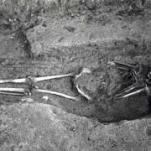Dublin's Foundations: A Viking Legacy
Published on 28th July 2010
 For three centuries, the Viking raiders of the North were the most feared pirates to haunt Europe's shores. At the end of the 8th century the great longboats slipped out of Scandinavia's fjords to begin a reign of terror. Thanks to their primary victims, the priests and monks of the early Christian churches, we have firsthand accounts of the pervasive fear the Viking threat instilled in medieval Europe. To be sure, the Vikings were fearsome warriors but the popular image of their murderous, pillaging ways only provides part of the picture!
For three centuries, the Viking raiders of the North were the most feared pirates to haunt Europe's shores. At the end of the 8th century the great longboats slipped out of Scandinavia's fjords to begin a reign of terror. Thanks to their primary victims, the priests and monks of the early Christian churches, we have firsthand accounts of the pervasive fear the Viking threat instilled in medieval Europe. To be sure, the Vikings were fearsome warriors but the popular image of their murderous, pillaging ways only provides part of the picture!
“Viking” was a profession for the Norsemen, a seasonal pursuit of wealth and plunder with which the North men could pay their taxes and feed their families that began in the late 8th century when Norway became too crowded and resources stretched too thin. The Vikings were ingenious engineers and their shipbuilding technology unparalleled for the time. They were tradesmen of the first calibre, who set up trade routes with the near and far East, with Constantinople and Italy. They explored and settled along all the coast of Europe, interbreeding with the native people and gradually assimilating with the populations. They settled Iceland, Greenland, Normandy – William the Conqueror was descended from Norse stock. By the middle of the 10th century, Dublin was an international hub of trade, dealing gold, silver, silks, weapons, horses, even people. Thanks to the Nordic settlers, Dublin would become one of the most profitable ports in all of Europe, with the largest slave markets since the fall of Rome.
Why did the Vikings even come to Ireland in the first place? When the Scandinavian explorers first made their way up the river Liffey, there was no such thing as Dublin. The deep black waters of the peat-basined Liffey appeared a “black pool” (Dubh Linn in Irish), and the river was an ideal shelter from the violent storms they were accustomed to in the Northern seas. Additionally, the temperate climate and access to vast forest made Ireland an ideal place to over winter; offering a haven to repair and rebuild their longboats during the Viking off-season. This initial Viking camp was called a Longphort, or ship fortress, and it would eventually grow to a thriving trading empire. Their nearest neighbours were at the small Irish village of Áth Cliath, barely worth the effort to plunder. As the Vikings became more deeply entrenched here, they would become involved in Irish politics, even hiring themselves as mercenaries to various Irish kings.
The Norse ruled Dublin until 1014 when they were defeated by Brian Boru’s army at the Battle of Clontarf. After this point, the Vikings become primarily a commercial presence in the city and continued to accumulate wealth. In 1171, Diarmaid Mac Murchadha, King of Leinster invited Richard De Clare, (better known as Strongbow) and his army of Anglo-Saxon mercenaries to Ireland to help Mac Murchadha reclaim his throne. In fortifying Dublin, Strongbow expelled the Vikings from their city, though the Norsemen only moved to the North side of the river and established their community resiliently. Over time, the Vikings became fully integrated with the rest of the Irish community.
Take a walk around Viking Dublin
View A walk around Viking Dublin in a larger map
Read More…
- John Bradley. Dublin in the Year 1000. Dublin City Public Libraries, 2003.
- Curriculum Development Unit. Viking and Medieval Dublin. Revised edition. Dublin: O’Brien Educational, 1988.
- Charles Haliday. The Scandinavian Kingdom of Dublin. Shannon: Irish University Press, 1969. First published 1881.
- Thomas Farel Heffernan. Wood Quay: the clash over Dublin’s Viking past. Austin, Texas: University of Texas Press, 1988.
- Ruth Johnson. Viking Age Dublin. Dublin: Town House, 2004.
- Hilary Murray. Viking and early medieval buildings in Dublin: a study of the buildings excavated under the direction of A.B. O Riordáin in High Street, Winetavern Street and Christchurch Place, Dublin, 1962-63, 1967-76. Oxford: British Archaeological Reports, 1983.
- Alfred P. Smyth. Scandinavian York and Dublin: the history and archaeology of two related Viking kingdoms. 2 Vols. Dublin: Irish Academic Press, 1979.
- Viking Dublin Exposed: the Wood Quay saga. Ed. John Bradley. Dublin: O’Brien Press, 1984.
- Patrick F. Wallace. The Viking Age Buildings of Dublin. 2 Vols. Dublin: Royal Irish Academy for the National Museum of Ireland, 1992.
Dublin City Archaeological Archive
The Dublin City Archaeological Archive (DCAA) was launched in 2008. This is a Dublin City Council project, managed jointly by Dublin City Archaeology, Dublin City Archives and Dublin City Council’s Heritage Office. The DCAA’s remit is to preserve records arising from archaeological investigations conducted in Dublin City by archaeologists working in the private sector, with special reference to excavations carried out before 2004.For further details, email [email protected]
The walk was devised by Kelsey Matters from Towson University, Maryland, USA. Kelsey was an intern at Dublin City Public Libraries, in summer 2010. She was funded by the EUSA (European Study Abroad) programme.
